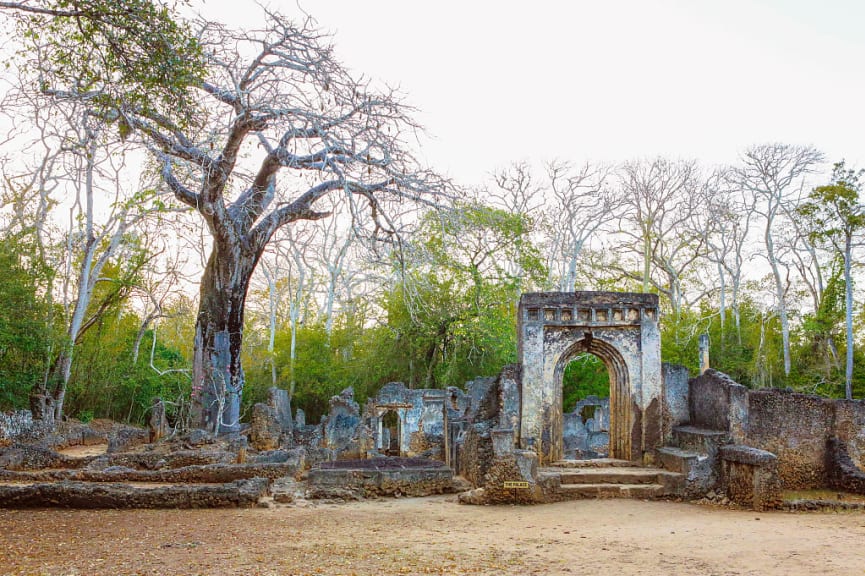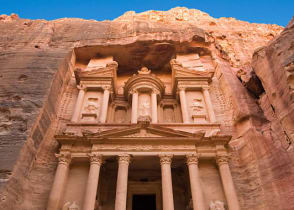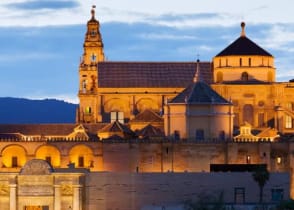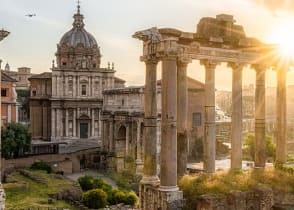Lost Cities Of The Past and Where to Visit Them
September 28, 2021

Virupaksha Temple, located in the ruins of ancient city Vijayanagar at Hampi, India
Ancient cities of the world represent dynamic, mythological, and legendary aspects of folklore that are critical to the history of humanity, and with the right travel specialist, you can immerse yourself in these as you explore the world.
The ruins of fascinating cities embody ancient life and reflect the strength and power of premodern kingdoms, the prestige of trading centers, and the scales of populations that far exceeds what modern archeologists once thought possible.
You can visit these cities that have been lost to history to find how they have shaped local modern-day culture and global heritage.
1. Great Zimbabwe, Zimbabwe

Great Zimbabwe Citadel
When thinking of Zimbabwe, most people immediately think of wildlife safaris, but the near-forgotten city of Great Zimbabwe was a powerful center of commerce located approximately 93 miles from modern-day Harare. It once boasted a central palace enclosed within a granite wall standing over 16 feet tall. The city acted as a major nucleus for the ivory, gold, and cattle trade in the region, before falling into disrepair and seemingly blending into the surrounding landscape of the verdant valley.
The site was built by the indigenous Bantu people in the 11th century. They reigned over the region for 300 years, their population there growing to as many as 18,000. Political instability, famine, water shortages, and decreasing trade in the region eventually caused the city’s decline, but remnants of the complex’s stone ruins remain.
2. Vijayanagar, India

Virupaksha Temple
Ancient civilizations and powerful empires often connect to fascinating history, and an example of this is the city of Vijaynagar. Located in South Bangalore, between the 14th and 16th centuries it boasted one of the world’s largest populations - twice the size of Paris at the time. The city acted as the center of the greatest empire in Southern India and was constructed around a number of holy sites, such as the still-standing Virupaksha Temple, a destination containing remaining temples and shrines revered across India by Hindus and non-Hindus.
The city brought traders from areas such as Persia and Portugal who were eager to trade with one of the wealthiest cities of the period. Merchants shared accounts of a “sacred” and “royal” center. Recent excavations have uncovered a series of palatial complexes, stone images, and terracotta artifacts.
3. Ani, Turkey

Ani Ruins
The city of Ani embodies the complex culture of Turkey by reflecting the stunning 10th-century capital of the Armenian kingdom, once considered the “City of 1001 Churches”. The surrounding green fields cast a unique ambiance as the remains of many of the original churches continue to emerge from the landscape with evocative power, showcasing the strength and wealth of a city once rivaling capitals like Damascus and Constantinople.
Some of the remaining churches highlight the beautiful aesthetic of the timeframe with foundations dating back to the 5th century AD. At the height of power, Ani hosted up to 200,000 citizens before the Mongol raids of the 13th century. The poignant ruins make for a remarkable destination set against the tranquil windswept plateau along the Turkish-Armenian border, often absent of crowds.
4. Petra, Jordan

Al-Khazneh temple in Petra
In the dry landscape of Wadi Musa, shining with the rusty and pink sandstone of the high desert, stands the hidden honeycomb of temples, tombs, and caves that comprises the complex of Petra. The city dates back approximately two millennia and was the capital of the Nabateans. It was a key center for the silk and spice trade between China, India, and southern Arabia in the east, and Egypt, Greece, and Rome in the west.
The Romans overtook the city in the 4th century AD, before Petra fell into the annals of history until the 19th century. Since then it has grown in fame after being highlighted in Indiana Jones and the Last Crusade as the city of Alexandretta. The monastery, carved into rock face with spectacular, intricate detail, right down to the sophisticated water system, signifies the enchanting architecture of a city that once supported 30,000 residents. Tourists visit Petra eager to witness the remains of architectural artwork carved into the colorful backdrop of stone.
5. Tiwanaku, Bolivia

Puma Punku, part of the Tiwanaku Site
The moral and cosmological center near the southeastern shores of Lake Titicaca in Bolivia, known as Tiwanaku, dates back to the 4th century BC and lasted until around the 4th century AD. The staggering monoliths drew pilgrims from around the Andes in South America and grew into an urban center between the 7th and 9th centuries AD as a precursor to the architectural prowess of the Inca.
Recent satellite imaging of the area suggests a complex much larger than the original estimated population of approximately 30,000 people. Archways, arcades, and two fantastic museums tell only a portion of the tale of the mythical, mysterious city. Little is known about the civilization that constructed the original monoliths before a drastic shift in the climate by 1000 AD eliminated food production.
6. Sukhothai, Thailand

Wat Mahathat at Sukhothai
Sukhothai was the first capital of an independent Thai state and dates back to the 14th century, when it gained freedom from the Angkor empire. The ancient city is located approximately five hours from Bangkok and contains ruins from its heyday in 1438, when it was home to some 80,000 residents. Thereafter, it was overtaken by its rival, the Ayutthaya kingdom.
The large, rectangular complex represents the remains of the once-vivacious capital, showcasing 26 temples and a captivating royal palace. The largest temple, Wat Mahathat, once served as the main religious center. It retains several enshrined Buddha relics, while Wat Si Chum Temple houses the giant white Buddha.
7. Mycenae, Greece

Ancient Mycenae
The remarkable ancient city of Mycenae stands on the Peloponnesian peninsula above the countryside strewn with poppies and grazing sheep. The renowned kingdom dates back to the Bronze Age in the 13th century BC and it controlled much of southern Greece, trading with centers in Crete and Egypt.
The kingdom hosted larger-than-life mythological figures and has acted as a tourist attraction since the Roman empire, with visitors eager to see the birthplace of heroes like Perseus and Agamemnon, infamous for his part in the Peloponnesian War recounted in Homer’s epic poem, The Iliad. The most prominent ruins include the beehive tombs known as tholoi and the stone lions gazing down from the eponymous gate, the entrance to the heart of the ancient city.
8. Gedi, Kenya

Ruins of Gedi, Kenya
The ruins of Gedi stand nearly 62 miles away from Mombasa, on the coast of Kenya, and date back to between the 13th and 17th centuries AD. Coral palaces, elaborate mosques, and townhouses represent important Swahili ruins hidden in the serene greenery of the gripping jungle. Archeologists uncovered signs of Arab and Bantu residents in the city, with some structures refurbished through the years.
A giant baobab tree supports several viewing platforms for visitors to discover the complex from an elevated perspective increasing the ethereal ambiance of the hidden, forgotten space. It also highlights the impressive medieval coastal power in which over 3,000 people once lived and traded with Persians, Arabs, Indians, Spaniards, Syrians, Egyptians, and the Chinese, with artifacts displayed in the elaborate museum.
9. La Ciudad Perdida, Colombia

La Ciudad Perdida, Colombia
The Spanish name for the destination in Colombia literally translates to “The Lost City” and captures the essence of a settlement forgotten by time and overtaken by the lush, emerald brush of the South American rainforest deep inside the Sierra Nevada mountains. What was once at the heart of the Tayrona civilization, founded in the 9th century AD, now requires a three-day hike, beginning in the city of Santa Marta.
Vines, trees, and underbrush entangle the tiled rooftops and elegant terraces, as well as circular plazas and sharp walls connected by 1,200 stairs that wind up the final ascent. The ruins’ remoteness and multi-day trek leave the complex largely empty for those who brave the terrain, providing a magnificent ancient discovery, unforgettable ambiance, unique perspective, and fascinating sense of accomplishment.
Want To Discover The World’s Lost Cities?

Sukhothai, Thailand
Ancient settlements help give context to the present, while providing an in-depth understanding of the lives of historical figures. Lost cities enchant archeologists, amateur historians, and tourists from around the globe eager to uncover more information about the ways in which these destinations shaped the world. Find inspiration for your cultural and historical tour with our Handcrafted Tours & Vacations. Ready to book your trip? Speak with a travel expert for your destination by filling out a Trip Request or call us on 1-888-265-9707.
Life-Enriching Travel Designed Just for You
- 1
Trips curated by the world’s top destination experts
- 2
Concierge-level service leading up to and during your trip
- 3
Unique, exclusive experiences and insider access





